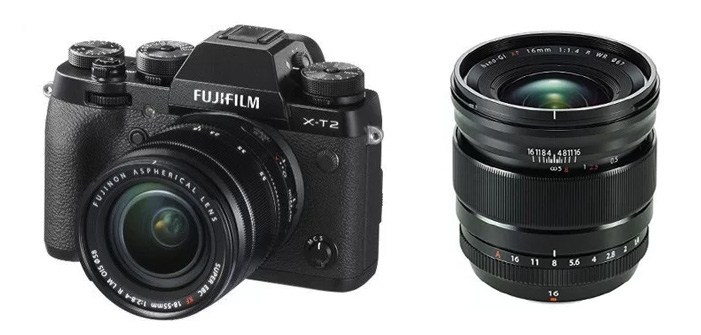The Fujifilm X-T2 is a fantastic camera with an ever-growing selection of Fuji’s optically superb lenses.
It has a great 24MP sensor, much improved auto focusing compared to its predecessor, 4K video recording and can shoot up to 11fps. As far as specifications go, the Fuji X-T2 is ready to shoot pretty much anything, whether it’s portraits, sports or even wildlife.
There isn’t one best lens for everything though (unless you want an all-around zoom), and while some of you prefer shooting with zooms, you might perhaps be looking for a couple of prime lenses. Our guide covers it all.
We’ve checked out a whole lot of Fujifilm lenses and selected only the ones that give you the most for the money.
Best Fujifilm X-T2 Lenses:
Fujifilm XF 14mm f/2.8 R
Fujifilm XF 16mm f/1.4 R WR
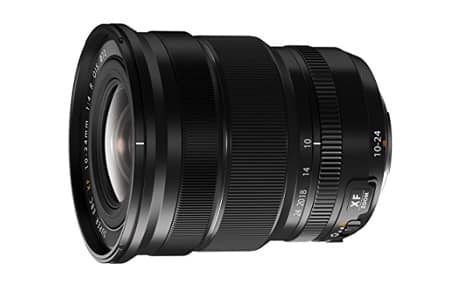 Fujifilm XF 23mm f/1.4 R
Fujifilm XF 23mm f/1.4 R
Fujifilm XF 23mm f/2 R WR
Fujifilm XF 27mm f/2.8
Fujifilm XF 35mm f/2 R WR
Fujifilm XF 35mm f/1.4 R
Fujifilm XF 50mm f/2 R WR
Fujifilm XF 56mm f/1.2 R
Fujifilm XF 10-24mm f/4 R OIS
Fujifilm XF 16-55mm f/2.8 LM WR
Fujifilm XF 18-55mm f/2.8-4 R LM OIS
Fujifilm XF 18-135mm f/3.5-5.6 R LM OIS WR
Fujifilm XF 50-140mm f/2.8 R LM OIS WR
Fujifilm XF 55-200mm f/3.5-4.8 R LM OIS
Fujifilm XF 100-400mm f/4.5-5.6 R LM OIS WR
If you decide to buy anything after clicking on our Amazon links, you automatically support us. It’s what allows us to write guides such as this one.
1. Fujifilm XF 14mm f/2.8 R
Great for landscape, indoors and architecture
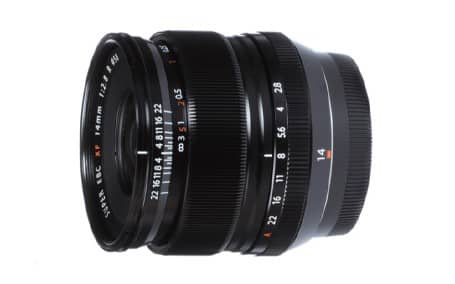
Landscape and architecture lovers will find the Fujifilm XF 14mm f/2.8 R lens a wonderful addition to their kit. Fujifilm lenses with the R designation have an aperture control ring allowing you to make aperture adjustments on the lens as well as from the camera body.
At a fixed 14mm focal length this prime lens has a wide angle field of view. The 1.5x crop factor of Fujifilm’s X-series sensors means the field of view of the 14mm f/2.8 is equivalent to 21mm on a full-frame sensor. The fast maximum aperture of f/2.8 means rapid shutter and autofocus speeds are achievable even in low light situations.
Sharpness and resolution are also maximized from the center to the periphery with no loss at the edges of the frame. At .52 lbs the lens is also extremely lightweight and comfortable to handle.
The XF 14mm also has molded aperture blades designed to enhance bokeh at the wider aperture settings. Bokeh are out of focus elements that appear as dream-like spheres in out of focus areas.
But the focal length and sharpness of this lens is better suited to landscape, indoors and architecture photography which means you’ll usually be using higher aperture values. Bokeh enhancement is a great bonus but may not come into play all that frequently.
You can buy it at Amazon or see more reviews here.
2. Fujifilm XF 16mm f/1.4 R WR
Great for landscape, indoors and astrophotgraphy
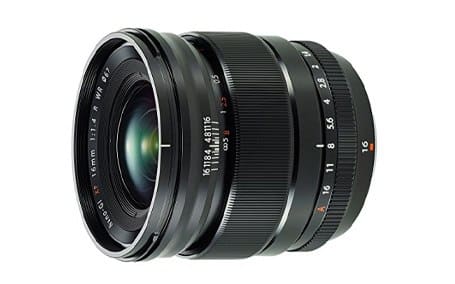
The Fujifilm XF 16mm f/1.4 R WR is a wide angle lens with a wide maximum aperture and a host of intriguing features. The field of view is equivalent to 24mm using a full-frame 35mm sensor. Like all Fujifilm lenses with the R designation the 16mm f/1.4 R WR has an aperture control ring which allows the photographer to adjust aperture on the lens itself.
This lens also includes a depth-of-field scale on the focus ring for instant distance calculations. Combined with a minimum focusing distance of 6 inches this lens is incredibly versatile.
The fast f/1.4 aperture combined with a two group floating focus system allows for auto focus speeds as quick as 0.11 seconds. And the nine rounded diaphragm blades work to enhance the bokeh of the background when used at maximum aperture.
Nine weather and dust seals in eight locations keep out unwanted elements and allow the lens to function at temperatures as low as 14F (-10 C). Seeing how the Fujifilm X-T2 is also weather-sealed, this combo is great for nature photography. Lastly, the Nano GI (Gradient Index) coating of the glass alters the refractive index between the lens glass and the air. The result is less ghosting and flare from incidental lighting.
At .83 lbs this lens is a little weightier than the others. Still, the XF 16mm is the premiere choice for travel, street, nature and landscape photographers.
You can buy it at Amazon or see more reviews here.
3. Fujifilm XF 23mm f/1.4 R
Sharp lens, perfect for landscape, portrait, wedding and street photography
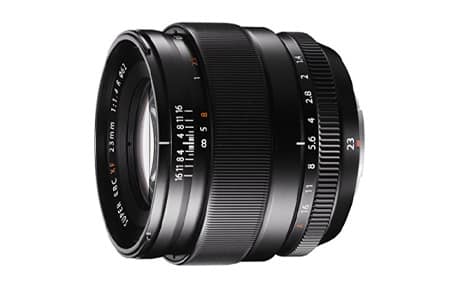
The Fujifilm XF 23mm f/1.4 R lens is perfect for photographers looking for a field of view that will always be useful.
With the Fujifilm’s X-series’s APS-C sized sensor the XF 23mm has a 35mm equivalent field of view. 35mm is incredibly versatile as it’s the field of view closest to that of the human eye. This makes this lens great for nearly any application including portraits, landscapes, architecture, and natural scenery.
Wedding and event photographers will find the f/1.4 maximum aperture especially pleasing. The fast aperture is perfect for low light photography and creates extremely shallow depths of field. The seven rounded aperture blades ensure beautifully artistic bokeh as well.
The glass has a multi-layered High Transmittance Electron Beam Coating (HT-EBC) that protects the surfce of the lens from scratching. The HT-EB coating also keeps light from scattering and ensures image contrast remains rich and vibrant.
The lens can focus as close as 11 inches with the close-up focusing control enabled or two feet when operated normally. It also has a camera to subject distance indicator and a depth of field scale on the barrel of the lens to aid manual prefocusing.
With a length of 2.84 in. and just 0.66 lbs in weight the 23mm f/1.4 R is the smallest and lightest non-pancake lens in this series. While it lacks the weather sealing of the 23mm f/2 R the faster aperture makes it the superior choice if cost is not an issue.
You can buy it at Amazon or see more reviews here.
4. Fujifilm XF 23mm f/2 R WR
Compact and great for traveling, portraits and landscape
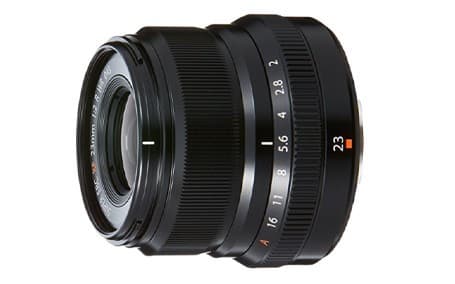
The Fujifim XF 23mm f/2 R WR is a rugged version of the 23mm f/1.4 R. At half the price, the f/2 R WR is a strong challenger. Although the aperture is not as wide f/2 is still a great aperture for portrait and event photography. It also allows for good performance in challenging lighting conditions.
The weather sealing of the f/2 R WR helps ensure the elements don’t penetrate, making it an excellent lens for nature and landscape photographers. This added protection allows normal operation down to 14 F (-10 C).
Although the field of view of the XF 16mm f/1.4 R WR is perfect for landscape lovers, the 23mm view of this lens is a 35mm equivalent on a full-frame sensor. 35mm is closest to the view of the human eye, making the XF 23mm f/2 a more versatile outdoor lens for scenes beyond nature.
The glass of this lens does not have the layered High Transmittance Electron Beam Coating (HT-EBC) of the 23mm f/1.4 R. Nor does it have the Nano-GI layer of the 16mm f/1.4 WR. Overall the 23mm f/2 R WR is a weather sealed middle ground lens but has slightly less image sharpness and clarity compared to its higher priced siblings.
You can buy it at Amazon or see more reviews here.
7. Fujifilm XF 27mm f/2.8
Super compact lens for traveling, landscape and casual photography
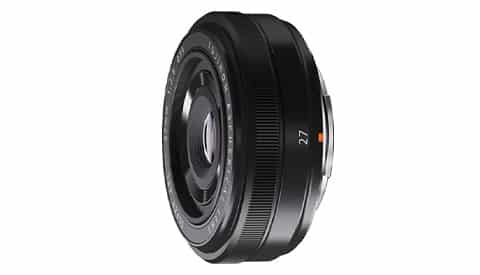
The Fujifilm XF 27mm f/2.8 is a pancake lens which means it has a compacted styling. The designs of these lenses can sometimes result in vignetting and poor image sharpness. However, the 27mm f/2.8 remains tack sharp throughout the frame.
Unlike other lenses, a pancake lens has no room for an adjustable aperture ring due to its smaller design. But at .17 lbs (2.75 oz) and a thickness of only 0.9 in., this lens is incredibly light. It keeps a camera pocket sized even with the lens attached. You definitely won’t attract much attention with this setup.
The multi-layered High Transmittance Electron Beam Coating (HT-EBC) on the surface of the glass helps protect against scratching. It also helps prevent contrast and sharpness loss through scattering of incidental light.
The 27mm field of view is equivalent to 41mm on a full-frame sensor. The field of view is similar to that of a 35mm but gives a bit more intimacy. This makes the 27mm f/2.8 ideal for street photography, whether you want to focus on a single subject, or capture a bigger scene. It’s also great for landscape and traveling.
While the aperture is not as wide as others the generalist focal length, price tag and pancake design make the 27mm f/2.8 a very attractive choice.
You can buy it at Amazon or see more reviews here.
5. Fujifilm XF 35mm f/1.4 R
Great for low light, portraits, casual photography and weddings
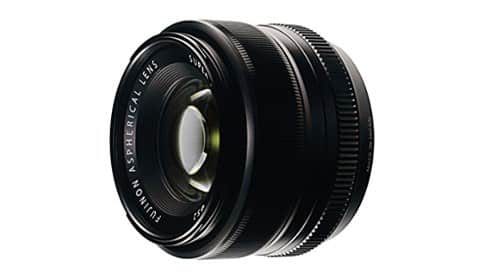
The Fujifilm XF 35mm f/1.4 R is a fantastic prime lens for portrait photographers. The bokeh created with the seven rounded aperture blades are incredibly attractive. And the wide open aperture of f/1.4 is well suited for creating good looking bokeh as well.
The focal length of this lens paired with the APS-C sized sensor of Fujifilm’s X-series is equivalent to 50mm on a 35mm sensor or film. 50mm is a very versatile field of view to work with. Being very close to the field of view of the human eye, 50mm works well for portraits, nature, and event photographers, but you can easily use it as your travel/walk-around lens. It’s also useful for close, indoor sports where you very close to your subject.
The 11-layer Super EBC (Electron Beam Coating) eliminates light flares off of lens surfaces by allowing 99.8% of incoming light to enter the camera. It also improves sharpness and color corrects the transmission spectrum of the glass so that all color wavelengths are transmitted equally.
The 35mm f/1.4 R also has an aperture ring with 1/3 of a stop adjustments for precision aperture control. Weighing in at 6.6 oz (0.41 lbs) the lens is incredibly light.
It competes fairly well with the XF 23mm f/1.4 R, but it’s newer and uses a High Transmittance EBC coating that also provides scratch resistance to the surface of the glass. Being a 35mm equivalent, the field of view is even better suited for the generalist photographer. But the 23mm f/1.4 R costs nearly twice as much, ensuring the 35mm f/1.4 R remains a good choice for the budget minded.
You can buy it at Amazon or see more reviews here.
6. Fujifilm XF 35mm f/2 R WR
Best outdoor travel lens. Compact, big aperture and standard field of view
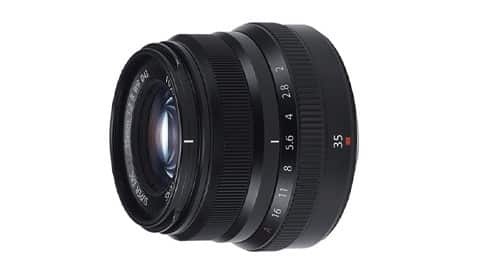
The Fujifilm XF 35mm f/2 R WR is suited for photographers who want a versatile focal length prime lens that can be used in all weather conditions.
Being a WR lens the 35mm f/2 is weather resistant, making it a great choice for outdoor photographers. Light rain and dust won’t penetrate any of the eight seals on the lens body. The lens will also operate normally in temperatures as low as 14F (-10C).
35mm is equivalent to a 50mm field of view using the APS-C sensors of the X-series cameras. And 50mm works very well for a wide variety of subjects, including portraits, nature, and event shots. It’s also the most recommended prime for traveling at Fujifilm’s blog.
f/2 is not as fast as f/1.4 but still allows in plenty of light for low light shoots. The depth of field will be shallow at this setting and will create excellent bokeh using nine aperture blades. This lens also has an inner auto focus system combined with a stepping motor for whisper quiet focusing and a response time as fast as 0.08 seconds.
The glass is very high quality and includes a Nano-GI (Gradient Index) coating. This layer changes the refractive index between the glass and surrounding air. In doing so ghosting and flares from incidental lighting are reduced or eliminated entirely.
You can buy it at Amazon or see more reviews here.
8. Fujifilm XF 50mm f/2 R WR
Affordable portrait lens, also great for outdoors, weddings and concerts
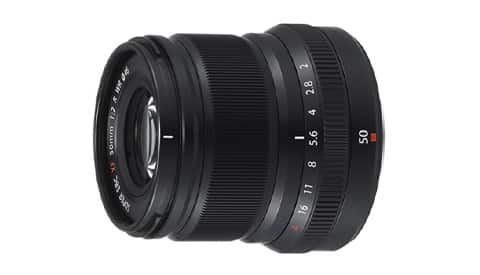
The Fujifilm XF 50mm f/2 R WR is a great lens if you want to photograph portraits and don’t want to be concerned with water or dust affecting your lens.
Using the APS-C sized sensors of the X-series cameras, the Fujifilm 50mm is equivalent to a 76mm prime lens using a full-frame field of view. 76mm is squarely in portrait territory. The features of subjects won’t suffer from distortion and enough of the scene shows up without taking away from the main subject.
This lens also has enough reach to be useful for candid street photographers who want to capture a subject without being too obtrusive. Nature photographers will also find this focal length fairly useful, though shy subjects may require a bit more reach.
f/2 is a fast aperture but if you want an even shallower depth of field, you should look at the bigger and heavier XF f/1.2 R, which has a 56mm focal length.
The 50mm f/2 R WR is almost identical to the 35mm f/2 R WR, but is slightly more expensive as it’s 2 years newer. Instead of a Nano-GI layer, the 50mm f/2 uses a Super Electron Beam coating. Both approaches have the same effect: control over ghosting and flare for improved image quality.
You can buy it at Amazon or see more reviews here.
9. Fujifilm XF 56mm f/1.2 R
Best choice for high quality portraits, indoor sports and low light
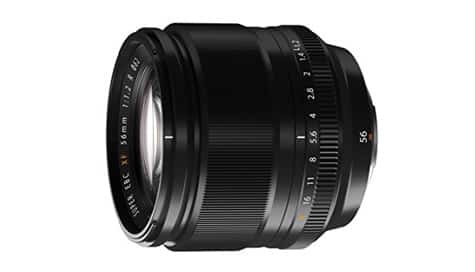
The Fujifilm XF 56mm f/1.2 R is our most recommended portrait lens, well suited for bokeh-rich photos from a slight distance.
The focal length of this lens combined with the fast aperture makes it one of the best portrait lenses available. With the APS-C sized sensor of the Fujifilm X-T2, the focal length is equivalent to 85mm on a full-frame sensor. 85mm creates a great separation between the subject and background of an image. It does also mean that some room to move is needed since this is telephoto territory.
The 56mm f/1.2 R has an 11-layer High Transmission Electron Beam Coating (HT-EBC) applied to both the front surface and a single layer on the opposite side. The HT-EBC helps stop chromatic aberrations and flare from incidental lighting. It also provides strong scratch resistance to the lens.
f/1.2 is very wide and allows for beautiful images and fast auto focus responses even in low light settings. The depth of field will be incredibly shallow as needed for maximum composition options. As an R lens, it also has an aperture ring on the barrel to control the aperture at will. Aperture and bokeh are further enhanced with the seven rounded aperture blades.
Fujifilm cameras with a Lens Modulation Optimizer (LMO) feature can partner with this lens to ensure sharpness and exposure are properly consistent throughout the aperture range. Th XF 56mm /1.2 is one of the more expensive ones on this list, yet is truly incomparably good. The focal length, features, and aperture are all top-notch. The only omission is no weather sealing, but that would make it even more expensive.
You can buy it at Amazon or see more reviews here.
Best Zoom Lenses for Fujifilm X-T2
1. Fujifilm XF 10-24mm f/4 R OIS
Perfect landscape and travel lens

The Fujifilm XF 10-24mm f/4 R OIS is a zoom lens well suited for architecture and street photographers who want a wide angle field of view. This range is also great for landscape photographers who need the expansive view.
OIS stands for Optical Image Stabilization; the f/4 R has built in elements to help control motion blur due to hand shake. This allows photographers to shoot handheld without sacrificing sharpness.
With a minimum focusing distance of 9.5 in (24 cm) this lens works well as a macro photography lens. And with the wide angle field of view the surroundings of the main subject will also be in full view. But with a maximum aperture of f/4 the user won’t be creating bokeh filled images.
The 10-24mm f/4 R also has a High Transmittance Electron Beam Coating (HT-EBC) to moderate lens flare and ghosting. The result is a boost in contrast and a reduction in chromatic abberation. The layer also protects against scratches. Lastly, this lens can pair with Fujifilm cameras that have a Lens Modulation Optimizer (LMO) setting to ensure exposure and sharpness remain consistent across the entire frame.
As a zoom lens its not directly comparable to the 14mm or 16mm lenses listed here. For photographers who want a shallower depth of field the prime lenses are the obvious choice. But if the user prefers scenes that need greater depth of field then this lens provides a wider range of focal lengths without sacrificing image quality.
You can buy it at Amazon or see more reviews here.
2. Fujifilm XF 16-55mm f/2.8 R LM WR
Great for portraits, traveling, journalism and indoors
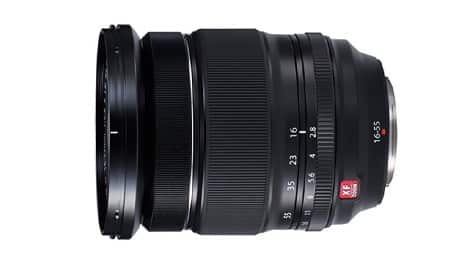
The Fujifilm XF 16-55mm f/2.8 R LM WR is a rugged, versatile lens that also comes with a fairly high price tag for these features.
The focal length of this lens covers a wide range. The full-frame equivalent is 24-84mm, giving us a near wide angle view at one end and a telephoto on the other. One of the downsides of this range is an increase in weight. At 1.44 lbs (23 oz) this lens is much heavier than the prime lenses from above.
It has LM (Linear Motor) for fast and reliable auto focusing, although as we mentioned above this is not super important for just portraits. From the wide angle/macro end the focusing distance is 11.8 in (30 cm) which allows you get close to the subject and still show parts of the background. f/2.8 is wide enough to create good looking bokeh as well, and thankfully the aperture size stays constant throughout the whole range.
This lens has both a Nano-GI and HT-EBC layer, giving it incredible optical properties. The coatings make glass is scratch-resistant and can suppress ghosting, lens flare, and chromatic aberrations from incidental lighting.
The XF 16-55mm also has an aperture control ring on the barrel for precision aperture control by hand. It has fourteen weather seals to prevent dust and rain from entering and ruining the camera. With a minimum operating temperature of 14F (-10C) this camera is a prime choice for nature photographers.
You can buy it at Amazon or see more reviews here.
3. Fujifilm XF 18-55mm f/2.8-4 R LM OIS
Affordable and optically stabilized travel/daily lens
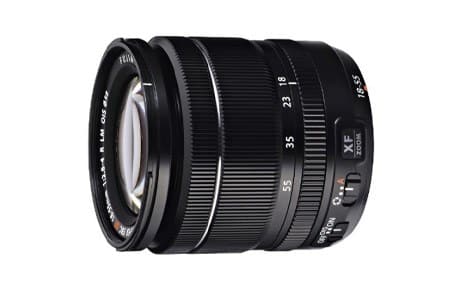
The Fujifilm 18-55mm f/2.8-4 R LM OIS is very similar in design to the 16-55mm f/2.8 but lacks several key features that help bring the price down.
This lens does not have weather resistance so it needs to be protected in rough environmental conditions. Also the lens stops down to f/4 maximum at the telephoto end. This means you’ll only get bokeh and shallower depths of field at the wide angle end which may not be all that useful.
The focal length range is equivalent to 27-84mm full-frame lens which is an incredibly versatile wide angle-telephoto range. That makes it great for everything from portraits to architecture. Overall this is a great street photography lens. Plus at .68 lbs (10.88 oz) this lens weighs half as much as the 16-55mm f/2.8.
The built in OIS (Optical Image Stabilization) helps keep image blur from becoming an issue while shooting handheld. With up to four stops of IS, you can shoot at 1/30 where you’d have to shoot with 1/500, assuming your subject is still.
Lastly the Nano GI (Gradient Index) coating of the glass alters the refractive index between the lens glass and the air. The result is less ghosting and flare from incidental lighting.
You can buy it at Amazon or see more reviews here.
4. Fujifilm XF 18-135mm f/3.5-5.6 R LM OIS WR
Best all-around zoom lens for traveling, landscape, outdoor activities
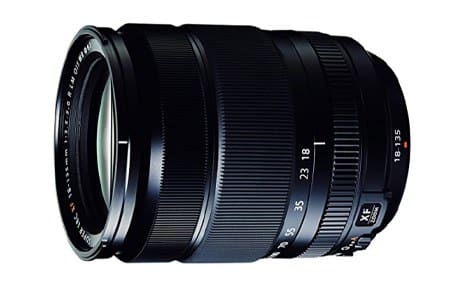
The Fujifilm XF 18-135mm f/3.5-5.6 R LM OIS WR is an extremely versatile lens meant to cover a wide variety of subjects. Everything from landscapes and architecture to portraits and wildlife are all possible with this lens.
Using the APS-C sized sensors for the X-series cameras the focal range is equivalent to a versatile 27-206mm on a full-frame body. The aperture is not very fast, however, which is typical of zoom lenses in order to cut costs. f/3.5 won’t give a wafer thin depth of field no matter the focal length. But the trade off is incredible versatility in captures in all weather conditions.
Shooting handheld with this lens is a pleasure even at 135mm. The lens combines the Linear Motor (LM) design with optical image stabilization (OIS) elements to create powerful motion blur compensation. Five stops of image stabilization help keep photos sharp even shooting handheld in low light settings.
As a WR (weather resistant) lens the XF 18-135mm has 20 seals to prevent dust and moisture from penetrating the interior of the lens. The lens can even operate in temperatures as low as 14F (-10C) making this a great choice for nature photographers who won’t let snow and rain keep them from getting the best shots.
The glass of this lens is coated with a High Transmittance Electron Beam Coating (HT-EBC) to reduce ghosting, lens flare, and chromatic aberrations. Image sharpness and contrast remain optimized. Also the coating provides extra scratch protection.
You can buy it at Amazon or see more reviews here.
5. Fujifilm XF 50-140mm f/2.8 R LM OIS WR
High quality choice for low light, sports, portraits, concerts and weddings
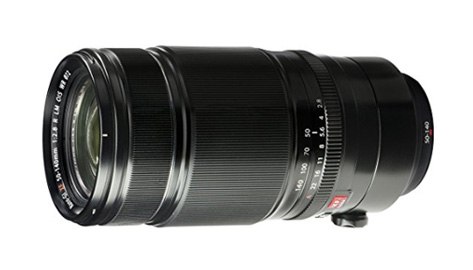
The Fujifilm XF 50-140mm f/2.8 R LM OIS WR is quite pricey but well worth the expense. The barrel is weatherized in 20 places to provide constant protection from dust and water splashes. The lens will operate normally even in conditions as cold as 14F (-10C).
Due to its big f/2.8 aperture across the entire focal range, it’s a perfect choice for outdoors and indoors sports, as well as zoo’s, pets, and animals in the nature that aren’t too far away. f/2.8 allows you to get nice sharp subjects and blurred backgrounds with beautiful looking bokeh, thanks to 7 rounded aperture blades.
At long focal lengths shooting without a tripod can cause loss of sharpness. Fortunately, the 50-140mm f/2.8 is stabilized via an Optical Image Stabilization (OIS) system that negates motion blur in images. The body also has a tripod mount on the barrel for even more image stabilization as needed as well as an aperture ring for precision aperture control.
Mounted on the Fujifilm X-T2, the lens has a full-frame equivalent focal length of 76-214mm. This makes it a solid zoom meant to bring far-off subjects into crisp focus and isolate them from the background. Portrait, street, and wildlife lovers will get a lot of use out of this focal range.
Notably the 55-200 f/3.5-4.8 which we talk about below, has an even better focal range for half the cost. However, you do lose out on the constant f/2.8 aperture across the range and the barrel tripod mount. The Fuji 50-140mm is weather sealed as well, making it more appropriate for photographing in difficult weather conditions. If range is all you want the f/3.5-4.8 will serve just as well, but the f/2.8 is well worth the additional money, especially if you know you will photograph in difficult light situations.
You can buy it at Amazon or see more reviews here.
6. Fujifilm XF 55-200mm f/3.5-4.8 R LM OIS
Affordable telephoto zoom for outdoors; wildlife and sports
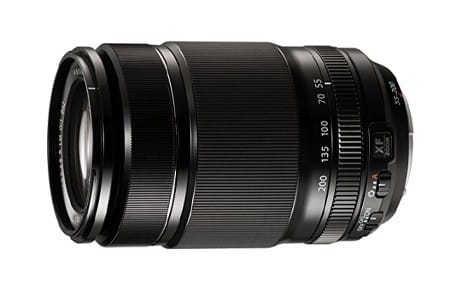
The Fujifilm XF 55-200mm f/3.5-4.8 R LM OIS is a fantastic outdoor sports, race, portrait and wildlife lens with a huge reach.
On the X-series’s APS-C sensor, this lens has a full-frame equivalent focal range of 84-305mm. With a 3.6 ft (1.1 m) minimum focusing distance, you need a bit of distance from the subject to capture the best view possible.
The barrel has an aperture ring for precision aperture control with 1/3 stop increments. The linear motor (LM) auto focus motors allow the lens to focus within 0.28 seconds and ensure the lens remains quiet and stable during focusing.
The Optical Image Stabilization (OIS) system provides up to four and a half stops of stabilization to make shooting handheld easier despite the long focal lengths. The glass also has a High Transmittance Electron Beam Coating (HT-EBC) to reduce ghosting, lens flare, and chromatic aberrations.
The 55-200mm f/3.5-4.8 is the toned down version of the 50-140mm f/2.8 lens. While the expanded focal range of the f/3.5 looks tempting the wider aperture of the latter lens is a tremendous advantage. The f/2.8 is also weather sealed for lovers of the outdoors. But for half the price of the f/2.8 the f/3.5 is still an excellent zoom lens. Keep in mind that because of its aperture, this is not a lens for indoors, so get it if you know you will mostly shoot outdoors (from races to sports, too wildlife, zoos and kids running around).
You can buy it at Amazon or see more reviews here.
7. Fujifilm XF 100-400mm f/4.5-5.6 R LM OIS WR
The ultimate choice for wildlife and outdoor sports photographers
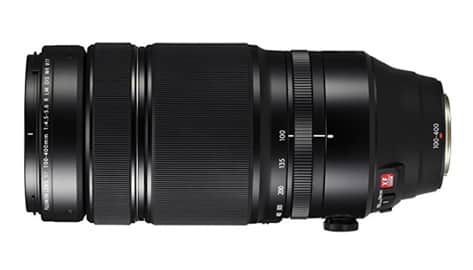 The Fujifilm XF 100-400mm f/4.5-5.6 R LM OIS WR is the ultimate choice for wildlife, sports and outdoor photographers. While its aperture is not as wide as the 50-140mm f/2.8, this lens is unbeatable when it comes to reach.
The Fujifilm XF 100-400mm f/4.5-5.6 R LM OIS WR is the ultimate choice for wildlife, sports and outdoor photographers. While its aperture is not as wide as the 50-140mm f/2.8, this lens is unbeatable when it comes to reach.
With the APS-C sized X-series sensor, it has an equivalent focal range of 150-600mm on a full frame sensor. Fortunately, it has a focus limiter switch to speed auto focus time. You can select between 5.7 ft (1.7 m) or 16.4 ft (5.0 m) out to infinity as the range the auto focus hunts through.
The barrel has both an aperture ring for precision manual aperture control, as well as a barrel tripod mount for additional image stabilization. The lens also has 13 weather seals to prevent dust and water splashes including light rain from penetrating into the barrel. Thanks to this, it can operate in temperatures as low as 14F (-10C).
The Fujifilm 100-400mm also has built in Optical Image Stabilization (OIS) that provides five stops of stabilization, to mitigate even the smallest amounts of motion blur from hand shake. This is extremely useful since hand holding such a big lens is not an easy task. The glass has a fluorine coating to protect against smudges and dirt, a common thing when shooting in the nature.
At 4.2 lbs (1.9 kg), this is the largest lens in Fuji’s series. However, the features and sheer reach of the 100-400mm f/4.5-5.6 R puts it in a league of it’s own. If you’re looking for the best sports/wildlife choice, this is it.
You can buy it at Amazon or see more reviews here.
Fujifilm Lens Terms:
XF – Highest quality Fujifilm lenses for X-mount (X-T2, X-T1 and so on)
WR – Weather Resistant construction
OIS – Optical Image Stabilization
LM – Linear Motor, allows faster and near silent focusing
R – The lens has a dedicated aperture ring
Types of Lenses:
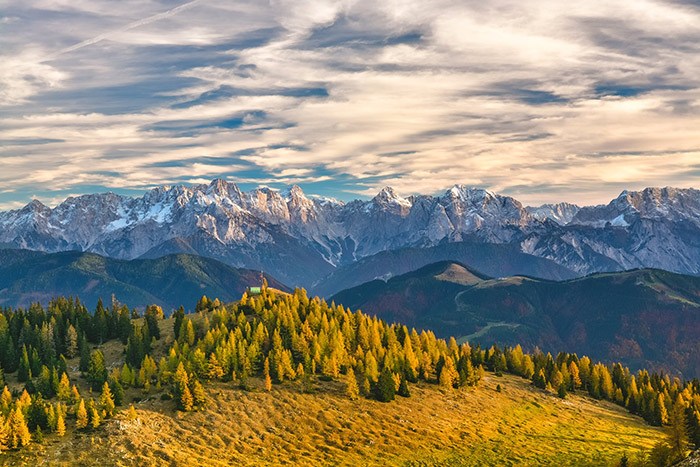
Wideangle lenses
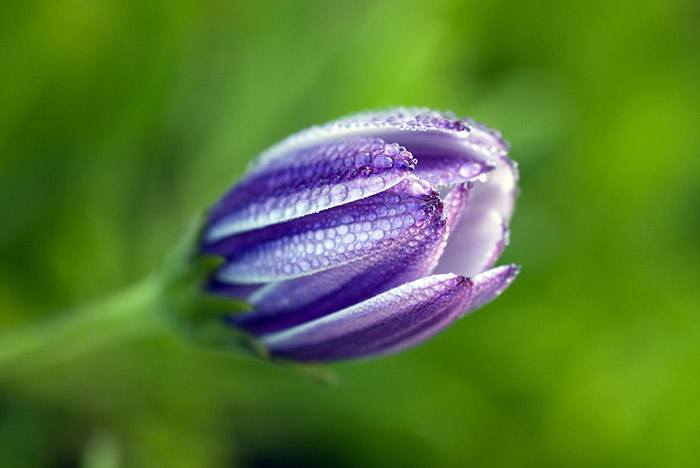
Macro lenses
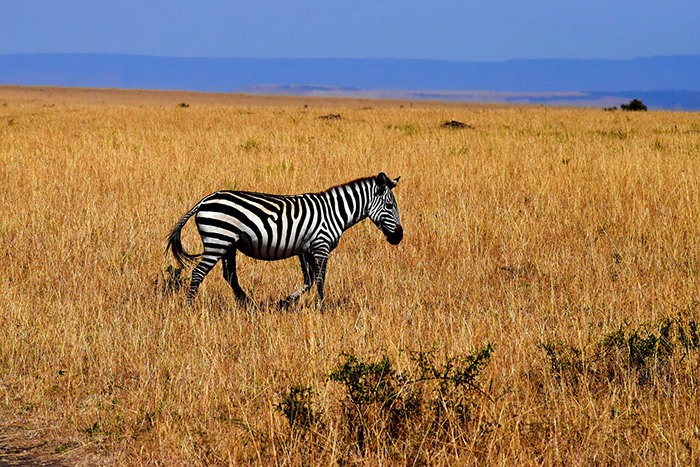
Telephoto lenses
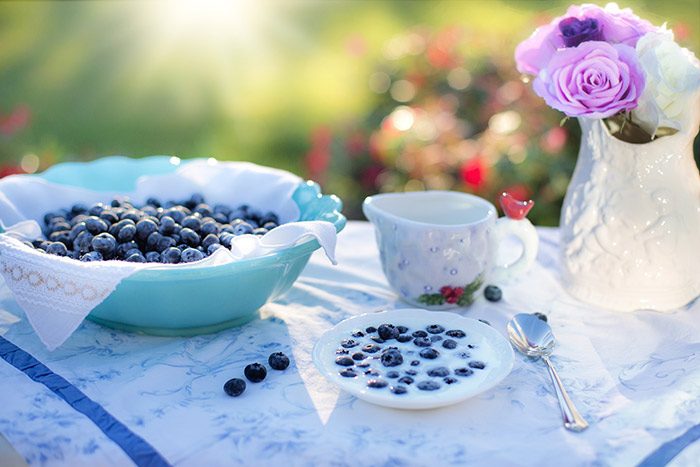
Standard lenses
- Wideangle – Useful for capturing a lot in your scene (usually from 12 to 23mm)
- Standard – Where most photography happens (from 23 to 56mm)
- Telephoto – For subjects far away (56 to 400mm)
- Macro – 1:1 ratio that magnifies your subject to real life size (usually from 60 to 180mm)
Wideangle Lenses:
Best for landscape, architecture, indoors, nature and the sky (astrophotography).
Standard Lenses:
Perfect for every day stuff, whether you’re taking pictures of your kids or shooting an outdoor event. The 23 to 56mm is a range that’s perfect for people, streets, traveling, weddings, food, you name it. Prime lenses in this range are affordable and have a big aperture so you can easily blur the background, but zooms give you good quality too, just with added weight and size.
Telephoto Lenses:
These allow you to get really close to your subject, and are great for sports, concerts and wildlife. Sure you can move closer to your subject, but sometimes that’s impossible or not worth the risk.
Macro Lenses:
Want to shoot bugs, small products, details or just want to explore the world that we don’t usually see? Macro lenses make your subject appear as big as it is in real life.
Our Top Fujifilm X-T2 Lenses:
If we only had to choose a few lenses, this is what we would go with.
Fujifilm XF 14mm f/2.8 R
Fujifilm XF 16mm f/1.4 R WR
 Fujifilm XF 23mm f/1.4 R
Fujifilm XF 23mm f/1.4 R
Fujifilm XF 23mm f/2 R WR
Fujifilm XF 27mm f/2.8
Fujifilm XF 35mm f/1.4 R
Fujifilm XF 35mm f/2 R WR
Fujifilm XF 50mm f/2 R WR
Fujifilm XF 56mm f/1.2 R
Fujifilm XF 10-24mm f/4 R OIS
Fujifilm XF 16-55mm f/2.8 LM WR
Fujifilm XF 18-55mm f/2.8-4 R LM OIS
Fujifilm XF 18-135mm f/3.5-5.6 R LM OIS WR
Fujifilm XF 50-140mm f/2.8 R LM OIS WR
Fujifilm XF 55-200mm f/3.5-4.8 R LM OIS
Fujifilm XF 100-400mm f/4.5-5.6 R LM OIS WR
Last Updated on September 14, 2021 by Nick Voorhees
First and foremost, I’m a husband and father. Then professionally I’m photographer, designer, blogger, and Esty store owner. My homebase is near the stunning Wasatch mountains in Utah but I love traveling with my family as part of our homeschooling journey. I also love teaching and helping out others. My faith is one of the biggest aspects of my life and brings be a consistent joy that I haven’t found in anything else. My main blog is BestPhotographyGear.com and I strive to make photography simple for anyone looking to learn or find gear for their individual needs. By nature, I like to study, research, and analyze things and I use that help provide the best advice and reviews I can.

